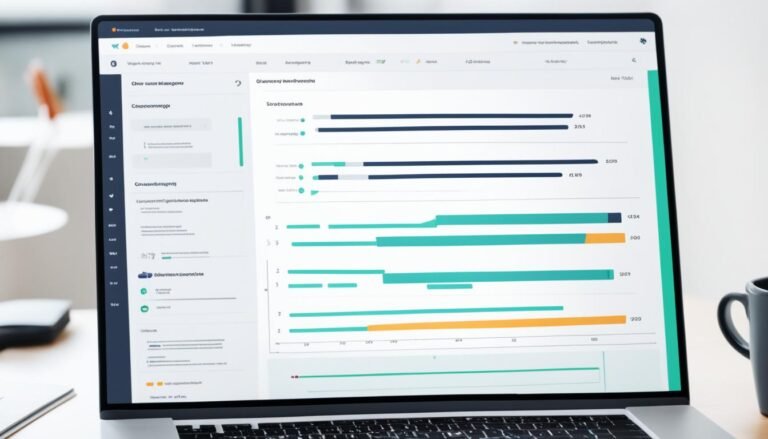AI and Data Analytics: Turning Data into Business Insights
Have you ever thought about how businesses quickly use the vast amounts of data we have today? They do so by applying AI and Data Analytics. These technologies give them a huge advantage in understanding data, unlike before.
AI reporting is changing the way we look at business data. It uses advanced data techniques, machine learning, and NLP to make sense of data. Tools like Akkio show its power, offering incredible speed, precision, adaptability, and options for how data is handled. They can process huge amounts of data from different sources.
Together, these technologies help businesses turn complex data into smart actions. This makes the process of understanding data faster and more efficient. AI reporting is making a big difference in many fields. For example, IBM’s Watson helps doctors create personalized treatment plans. Amazon’s engine improves user experience by suggesting products based on behavior.
Let’s look into how AI and Data Analytics are changing the game for businesses. They’re making data more valuable than ever before.
Key Takeaways
- AI and Data Analytics integrate advanced data processing, machine learning, and NLP to derive actionable insights from complex datasets.
- AI reporting solutions like Akkio offer speed, accuracy, scalability, and customization, enhancing operational efficiency.
- Traditional data analysis methods struggle with big data’s volume and complexity, making AI tools essential for businesses.
- Machine learning algorithms and NLP are critical components, enabling sophisticated data analysis and human-readable summaries.
- AI-driven innovations are transforming sectors, from healthcare’s personalized treatment plans to supply chain management’s demand forecasting.
Introduction to AI and Data Analytics
Artificial intelligence teaming up with data analytics is changing how companies use information. It automates making decisions and forecasts the future trends. This combo, AI Analytics, is at the heart of business plans, providing insights quickly for better efficiency and staying ahead.
What is AI Analytics?
AI Analytics merges artificial intelligence with strict data analysis to offer quick insights. It uses machine learning and forecasting to make reviewing data simpler and faster. AI Analytics boosts how businesses work and helps understand what customers and the market want.
The Evolution of Data Analytics
The Data Analytics Evolution story goes from manual reports to smart AI systems. At first, companies handled data with basic tools. But AI brought big improvements, allowing for advanced analysis. CloudComputingTechnologies.AI is a great example. It smoothly adds AI to old systems, improving efficiency without the big change.
The Increasing Importance of Data in Business
Data is key in today’s economy. From healthcare to retail, AI data analytics help find important insights. In healthcare, it speeds up spotting diseases and personalizes treatments. In retail, it makes shopping better with suggestions based on what customers like. This way, businesses can quickly adapt to what the market needs.
The Role of Machine Learning Algorithms in Data Analytics
Machine Learning in Analytics has changed how we deal with big data. It gives us better accuracy and speed when working with large amounts of information. Companies use this to find hidden insights in their data.
Commonly Used Machine Learning Algorithms
Some essential algorithms help in AI reporting and analytics:
- Regression Analysis: It’s vital for predicting future trends from past data.
- Clustering: Places similar data points into groups, which is useful for understanding customers better.
- Decision Trees: This algorithm lays out possible outcomes, making complex decisions easier.
- Neural Networks: They work like the human brain, identifying intricate patterns in data.
These tools make preparing data and predictive modeling better. For example, Google uses them in search rankings and natural language processing. This effort improves how people use the internet.
Applications of Machine Learning in Business
Machine Learning helps different industries in various ways:
- Customer Insights: Domo’s AI Dashboard combines data to understand how customers behave and what they like.
- Personalized Marketing: Apptus eSales uses insights to show customers products they’re likely to buy, enhancing their shopping experience.
- Operational Efficiency: At Walmart, the SAP HANA cloud speeds up the analysis of sales data, making their supply chain management better.
- Real-Time Decisions: Pinterest and Twitter use machine learning to improve user experiences, managing posts and content dynamically.
In retail, machine learning helps change product prices on-the-fly. It also automates credit checks for car buyers. This real-time approach keeps businesses ahead in a quick-moving market.
Integrating Machine Learning in Analytics gives companies powerful tools for growth. It makes daily operations smoother and helps make better strategic choices.
Predictive Analytics: Forecasting the Future
In today’s world, predictive analytics is key in predicting future trends and improving how businesses run. It uses old data and smart algorithms to guess how customers might act and where markets are heading. The market for this kind of analytics was worth $12.49 billion in 2022. It’s expected to reach $38 billion by 2028, growing about 20.4% each year.
Understanding Predictive Modeling
Predictive modeling looks at old data to guess what might come next. It uses tools like decision trees, regression, and neural networks. These networks are models after how our brains think. Big names like Rolls-Royce and PepsiCo have used these tools to improve how they do things.
Rolls-Royce, for example, cuts down on pollution and better sets up maintenance. PepsiCo guesses when they might run out of products and changes how they sell. This shows how powerful predictive modeling can be.
Use Cases of Predictive Analytics in Various Industries
Predictive analytics is being used in many different fields. In retail, it helps guess what products will be needed, plan deliveries, and boost sales. Airlines adjust ticket prices using past flight patterns. Aerospace firms use it to see how maintenance affects planes.
Car makers look at old part failures to improve their designs. And in finance, they predict risk and market trends. Hospitals use it to set work schedules and spot patients who might need special care. All this saves a lot of money.
There are many other ways businesses use predictive analytics. It can help create new customer leads, upsell, and keep valued customers. It guides smart decisions and makes companies work better. This stuff isn’t just for big names. Small businesses use it too to plan and avoid problems.
Knowing about predictive modeling helps businesses get ready for what’s next. As AI gets more involved, this kind of analytics gets even better. It’s a key part of how companies make plans today.
Data Visualization Tools: Making Data Understandable
Data visualization turns complex data into clear insights. It’s key for better data understanding, especially in AI. By presenting findings clearly, data visualization plays a big role in AI analytics.
The Importance of Data Visualization
Good data visualization is crucial for analytics. It lets groups work out big data and share what they find. This process helps with spotting trends and making smart choices based on the data.
It bridges the gap between looking at the data and making real-world decisions. This makes business moves faster and more clever.
Popular Data Visualization Tools
Many tools are great for different needs. The top picks for 2024 include Tableau, Looker, Zoho Analytics, and more. These tools help turn complex data into easy-to-understand visuals.
Tableau is easy to get into with a 14-day free trial for beginners. While it may not fit every budget, its user-friendliness stands out.
Zoho Analytics fits well within the Zoho suite and is budget-friendly. It starts at about A$34.1 a month, which is good for smaller groups.
Sisense focuses on speed, working well on phones and with big data sets. IBM Cognos uses AI to give insights and offers a 30-day free trial. Starting at A$20.87 a month, it might be a bit tricky to learn but offers a lot of value with its AI features.
Looker is great for keeping data safe and exploring it in real time. It does have a learning curve and few customization options. Still, it’s a top pick for handling real-time data.
Microsoft Power BI, Klipfolio, and SAP Analytics Cloud also have their strengths. They help businesses work with data by creating interactive reports and dashboards. This makes understanding data easier and more useful for making decisions.
Business Intelligence Solutions: Enhancing Decision Making
In today’s world, using Business Intelligence Solutions is crucial for companies. They help achieve important goals. These solutions turn big sets of data into useful Business Insights, improving important Data-Driven Decision Making.
Tools like Akkio’s AI reporting make work more efficient. They help notice patterns quickly and fit well into how a company works.
Surprisingly, 85% of BI projects don’t reach their goals, showing the difficulties companies face. Yet, many fields like healthcare, finance tech, and manufacturing are using BI tools more. This is because it helps them make choices easier and faster. For example, healthcare uses data to find high-risk patients early, cutting down on costs.
In finance tech, these tools change raw data into useful actions. They make financial work smoother and help in making better choices. Manufacturers also love BI because it makes their operations better. It helps them produce more efficiently, which is good for their long-term plans.
Retail shops use BI for better pricing and supply chains, which gives them an edge over others. Government groups and nonprofits see huge benefits from BI too. They help make policies smarter, run smoother, and save a lot of money.
In energy, BI is key for predicting power outages and using energy better. This shows how important BI is in many fields.
The big push for Data-Driven Decision Making comes from the many benefits of BI. Companies that don’t use data well might fall behind those that do. Having good data in one place helps make better choices.
Modern BI platforms are made for everyone, not just tech experts. They let anyone look at the data and find important insights. They also show clear metrics on dashboards, making it easier to track how well things are going.
The future for BI looks good, with AI and machine learning joining in. This means more advanced analytics and predictions. Real-time data will give fast insights, helping make decisions quickly and smartly.
“Business Intelligence Solutions can undoubtedly lead to competitive advantage by providing insightful decision-making capabilities.”
AI and Data Analytics: Turning Data into Business Insights
In 2016, SK Sharma changed Ingrooves Music Group by joining as its chief analytics and AI officer. He wanted to change how the company distributed global music and marketed indie artists. Sharma brought together a team of data scientists, building a strong AI pipeline in the music world. This move shows how turning data into business insights can help creative fields.
AI and Data Analytics bring big benefits to many areas. For example, in manufacturing, they make operations more efficient by improving yield and cutting waste. They’re also used to pick up on customer feelings in businesses and to spot supply chain problems early. Jason Hardy from Hitachi Vantara explained that top executives value AI and machine learning, yet many don’t know how to start using them.
AI tools for reporting provide quick, useful insights. They use complex algorithms to turn deep data patterns into smart business moves. In healthcare, IBM’s Watson for Oncology uses AI to personalize cancer treatment. In finance, these tools help lower incorrect fraud alerts, showing the wide use of AI reporting tools.
In marketing, AI uses social media data to create focused campaigns and improve interactions with customers. In manufacturing, AI helps with predictive maintenance to stop equipment failures and lessen downtimes. These uses prove AI and Data Analytics change traditional ways, bringing real benefits across fields.
The growth of AI toward cloud-based tech and stronger processing means less need for physical systems. Plus, sensors through IoT give key data for AI operations. Mixing AI and Data Analytics into current systems is key for complete, efficient, and sustainable solutions in business.
Data-Driven Decision Making: Empowering Business Leaders
In today’s world, just trusting our gut to make business decisions isn’t enough. Surveys show more than half of Americans still go with their instinct, even if facts suggest otherwise. But, organizations that heavily use data are much more likely to make better decisions. They are three times more likely to improve decision-making than those who don’t use as much data.
Benefits of Data-Driven Decision Making
Making decisions based on data brings clear benefits. Companies who rely heavily on data are more productive and profitable. They are 4% more productive and 6% more profitable than those who aren’t. Big companies like Amazon benefit a lot; their recommendations led to 35% of sales in 2017.
Data-based strategies help companies to focus on real goals and track their progress. For example, Google uses data to see how managers affect their team’s work and happiness. This shows how valuable data is in creating successful plans.
Challenges and Solutions in Implementing Data-Driven Strategies
Using data for decisions isn’t without its issues. Privacy worries and making AI work with current systems are key hurdles. To overcome these, companies can use AI tools designed for their needs. They also need a solid plan for putting data to work.
Nearly half of organizations have saved by using big data to cut costs. This shows the big rewards when businesses tackle these issues well. The key is to face these problems directly and balance new ideas with protecting data and making sure they work well practically.
“Highly data-driven organizations are three times more likely to report significant improvements in decision-making.” – PwC Survey
Artificial Intelligence Technologies: Revolutionizing Analytics
AI technologies are transforming data analytics. They use machine learning and NLP to interpret data better. This makes predictive analytics more accurate, helping businesses make smarter decisions.
Key AI Technologies in Data Analytics
Machine learning is a big part of AI in analytics. It finds hidden patterns in large data sets. This is very useful in finance and healthcare for understanding complex information.
NLP is also key. It lets machines understand human languages, like social media or reviews. This helps businesses know what customers think and predict trends better.
AI also boosts predictive analytics. It looks at past data to predict future outcomes. For example, it can guess customer behavior, market changes, or even health trends. This helps companies plan ahead and act proactively.
Examples of AI Technologies in Action
Akkio uses AI to improve music service. It learns what people like and tailors recommendations. This boosts listener satisfaction and artist interactions.
In finance, AI catches fraud in real time. It prevents losses by getting smarter with time. It also makes data work faster, cutting down mistakes and making things run smoother.
AI also helps protect data from breaches. It gives companies an edge by making better decisions. Real-time AI tools let businesses react quickly, a big plus in finance or e-commerce.
In the end, AI changes how we use data, giving us quicker and better insights. It’s a major player in smart business moves. This tech makes companies leaders through its predictive power and advice.
Case Studies: AI and Data Analytics in Action
AI and Data Analytics are making big changes in many fields. Microsoft moved their offices and cut meeting travel time by 46 percent, saving $520,000 yearly. Uber used COTA for customer support. They reduced ticket resolution time by 10 percent and handled each problem quicker after testing COTA v2.
Success Stories Across Different Industries
PepsiCo’s Pep Worx targeted 24 million houses, pushing up Quaker Overnight Oats sales by 80 percent. This shows the power of data in boosting product sales. On a similar note, AI at Blue Apron brought forecasting errors down to less than six percent. This shows how precise predictions can be, helping businesses save money.
Netflix uses AI for its recommendations, which guide over 80 percent of what people watch. Amazon has used AI to better organize its supply chain, cutting shipping costs and improving delivery times. These cases show how crucial AI and data are in modern businesses.
Lessons Learned from Real-World Applications
Microsoft and Uber’s examples teach us important things. They show AI can save money and make things work better. By learning from these success stories, businesses can make smarter decisions and understand their customers better.
Netflix and Amazon are also great cases to look at. They show that using AI can make customers happier. When a business understands its clients and runs more smoothly, everybody wins.
Future Trends in AI and Data Analytics
Looking ahead, AI and Data Analytics are on the verge of big changes. These shifts will be powered by new tech and fresh ideas.
Emerging Technologies and Innovations
Gartner predicts that by 2024, a big piece of AI data will model reality and project the future. This is a big step forward from 2021, showing how fast technology is growing. They also want to make data easy for everyone in an organization to use, which would create a more open data culture.
Studies by Randy Bean show that more companies are building a culture based on data thanks to AI that explores new ideas. But, Alteryx’s research shows that there are still hurdles. Organizations face problems like putting advanced analytics to work and making sure workers have the right skills.
Predictions for the Next Decade
By 2024, Gartner says 74% of organizations will start using AI for real business benefits. They also say that harder analytics bring more value. AI and ML will help with understanding the future, suggesting actions, and offering real-time insights.
Government agencies are using advanced analytics to study climate change. For instance, Teradata Vantage helps by training models on lots of daily data and supporting detailed use cases.
More and more, businesses see the worth of AI and analytics. This demand highlights the need for better team training and collaboration. For the financial world, AI and ML analysis can quickly spot fraud, making things safer.
On the other hand, Emerging AI Technologies are automating responses through chatbots. This eases the workload and improves customer service. It shows a push for custom-tailored customer interactions, better NLP, and smarter ways to solve data issues in the coming years.
Challenges and Ethical Considerations
AI and Data Analytics face key challenges and ethical issues in evolving fields. These include data privacy, security, and reducing AI bias. Managing these well is crucial for trust in our data-heavy world.
Data Privacy and Security Concerns
Industries like healthcare and finance are highlighting data privacy issues. With the advent of GDPR, data protection and transparency discussions are growing. AI use raises privacy concerns, demanding strong cybersecurity to protect customer data.
Addressing Bias in AI and Data Analytics
Algorithmic bias is a critical concern in AI. Machine learning can make unfair decisions based on past biases. To combat this, using transparent methods and human oversight is vital. Such efforts ensure fairness and trust in decision-making.
Focusing on ethics in AI brings regulatory and strategic benefits. Approaching innovation with a view to privacy and fairness leads to growth and positive impacts. By tackling ethical challenges, businesses can leverage AI while keeping customer trust.








